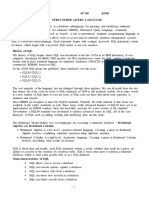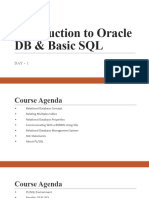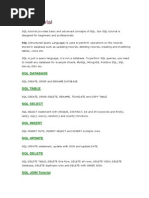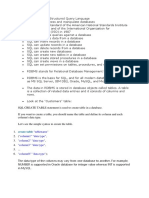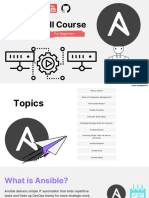0 ratings0% found this document useful (0 votes)
9 viewsIntro About SQL
Uploaded by
mehnaaz1579Copyright
© © All Rights Reserved
Available Formats
Download as ODT, PDF, TXT or read online on Scribd
0 ratings0% found this document useful (0 votes)
9 viewsIntro About SQL
Uploaded by
mehnaaz1579Copyright
© © All Rights Reserved
Available Formats
Download as ODT, PDF, TXT or read online on Scribd
You are on page 1/ 4
INTRODUCTION ABOUT SQL
Structured query language (SQL) is a programming
language for storing and processing information in a
relational database. A relational database stores
information in tabular form, with rows and columns
representing different data attributes and the
various relationships between the data values. You
can use SQL statements to store, update, remove,
search, and retrieve information from the database.
You can also use SQL to maintain and optimize
database performance.
Structured query language (SQL) is a popular query
language that is frequently used in all types of
applications. Data analysts and developers learn and
use SQL because it integrates well with different
programming languages. For example, they can
embed SQL queries with the Java programming
language to build high-performing data processing
applications with major SQL database systems such
as Oracle or MS SQL Server.
SQL was invented in the 1970s based on the
relational data model. It was initially known as the
structured English query language (SEQUEL). The
term was later shortened to SQL. Oracle, formerly
known as Relational Software, became the first
vendor to offer a commercial SQL relational
database management system.
INTRODUCTION ABOUT SQL
Structured query language (SQL) commands are
specific keywords or SQL statements that developers
use to manipulate the data stored in a relational
database. You can categorize SQL commands as
follows.
Data definition language
Data definition language (DDL) refers to SQL
commands that design the database structure.
Database engineers use DDL to create and modify
database objects based on the business
requirements. For example, the database engineer
uses the CREATE command to create database
objects such as tables, views, and indexes.
Data query language
Data query language (DQL) consists of instructions
for retrieving data stored in relational databases.
Software applications use the SELECT command to
filter and return specific results from a SQL table.
Data manipulation language
Data manipulation language (DML) statements write
new information or modify existing records in a
INTRODUCTION ABOUT SQL
relational database. For example, an application
uses the INSERT command to store a new record in
the database.
Data control language
Database administrators use data control language
(DCL) to manage or authorize database access for
other users. For example, they can use the GRANT
command to permit certain applications to
manipulate one or more tables.
Transaction control language
The relational engine uses transaction control
language (TCL) to automatically make database
changes. For example, the database uses the
ROLLBACK command to undo an erroneous
transaction.
INTRODUCTION ABOUT SQL
You might also like
- Sentiment Analysis of Restaurant Review - Project ReportNo ratings yetSentiment Analysis of Restaurant Review - Project Report20 pages
- What is SQL_ - Structured Query Language (SQL) Explained - AWSNo ratings yetWhat is SQL_ - Structured Query Language (SQL) Explained - AWS6 pages
- Structured Query Language Introduction To SQLNo ratings yetStructured Query Language Introduction To SQL23 pages
- SQL (Structured Query Language) Is A Database ManagementNo ratings yetSQL (Structured Query Language) Is A Database Management7 pages
- DAY-1 - Introduction To Oracle DB & Basic SQLNo ratings yetDAY-1 - Introduction To Oracle DB & Basic SQL37 pages
- Title: Implementation of DDL Commands of SQL With Suitable ExamplesNo ratings yetTitle: Implementation of DDL Commands of SQL With Suitable Examples11 pages
- Chapter 2 Grade 12 Programming and Structure Query Language SNo ratings yetChapter 2 Grade 12 Programming and Structure Query Language S32 pages
- SQL Stands For Structured Query LanguageNo ratings yetSQL Stands For Structured Query Language22 pages
- History: Query Language), Was Designed To Manipulate and Retrieve Data Stored in IBM's OriginalNo ratings yetHistory: Query Language), Was Designed To Manipulate and Retrieve Data Stored in IBM's Original8 pages
- Oracle Quick Guides: Part 3 - Coding in Oracle: SQL and PL/SQLFrom EverandOracle Quick Guides: Part 3 - Coding in Oracle: SQL and PL/SQLNo ratings yet
- The Creation and Inheritance of Digital Afterlives You Only Live Twice 1St Edition Debra J Bassett Full Chapter100% (14)The Creation and Inheritance of Digital Afterlives You Only Live Twice 1St Edition Debra J Bassett Full Chapter77 pages
- Basic Calculus 11 q4 Quarterly AssessmentNo ratings yetBasic Calculus 11 q4 Quarterly Assessment3 pages
- syllabus Cryptography and Network SecurityNo ratings yetsyllabus Cryptography and Network Security5 pages
- On Spatialization Author(s) : James Dashow Source: Computer Music Journal, Fall 2013, Vol. 37, No. 3 (Fall 2013), Pp. 4-6 Published By: The MIT PressNo ratings yetOn Spatialization Author(s) : James Dashow Source: Computer Music Journal, Fall 2013, Vol. 37, No. 3 (Fall 2013), Pp. 4-6 Published By: The MIT Press4 pages
- IT Governance Mechanisms in Managing IT Business VNo ratings yetIT Governance Mechanisms in Managing IT Business V11 pages
- S7-PDIAG - For S7-300 and S7-400 - First StepsNo ratings yetS7-PDIAG - For S7-300 and S7-400 - First Steps16 pages
- Indicator NAS Ultimate Algo Remastered for TradingViewNo ratings yetIndicator NAS Ultimate Algo Remastered for TradingView6 pages
- Kumon Connect Operational and Technical FAQ - June 5 2023No ratings yetKumon Connect Operational and Technical FAQ - June 5 202311 pages
- SEDCO Kiosk Solution Customer Visit ManagementNo ratings yetSEDCO Kiosk Solution Customer Visit Management2 pages
- File Handling in R Programming: Eg: File - Create ("GFG - TXT")No ratings yetFile Handling in R Programming: Eg: File - Create ("GFG - TXT")2 pages
- Sentinel 2 Products Specification DocumentNo ratings yetSentinel 2 Products Specification Document524 pages
- Listening Project_question Type 1_ Pick From a List_studentNo ratings yetListening Project_question Type 1_ Pick From a List_student3 pages
- Sentiment Analysis of Restaurant Review - Project ReportSentiment Analysis of Restaurant Review - Project Report
- What is SQL_ - Structured Query Language (SQL) Explained - AWSWhat is SQL_ - Structured Query Language (SQL) Explained - AWS
- SQL (Structured Query Language) Is A Database ManagementSQL (Structured Query Language) Is A Database Management
- Title: Implementation of DDL Commands of SQL With Suitable ExamplesTitle: Implementation of DDL Commands of SQL With Suitable Examples
- Chapter 2 Grade 12 Programming and Structure Query Language SChapter 2 Grade 12 Programming and Structure Query Language S
- History: Query Language), Was Designed To Manipulate and Retrieve Data Stored in IBM's OriginalHistory: Query Language), Was Designed To Manipulate and Retrieve Data Stored in IBM's Original
- Oracle Quick Guides: Part 3 - Coding in Oracle: SQL and PL/SQLFrom EverandOracle Quick Guides: Part 3 - Coding in Oracle: SQL and PL/SQL
- The Creation and Inheritance of Digital Afterlives You Only Live Twice 1St Edition Debra J Bassett Full ChapterThe Creation and Inheritance of Digital Afterlives You Only Live Twice 1St Edition Debra J Bassett Full Chapter
- On Spatialization Author(s) : James Dashow Source: Computer Music Journal, Fall 2013, Vol. 37, No. 3 (Fall 2013), Pp. 4-6 Published By: The MIT PressOn Spatialization Author(s) : James Dashow Source: Computer Music Journal, Fall 2013, Vol. 37, No. 3 (Fall 2013), Pp. 4-6 Published By: The MIT Press
- IT Governance Mechanisms in Managing IT Business VIT Governance Mechanisms in Managing IT Business V
- Indicator NAS Ultimate Algo Remastered for TradingViewIndicator NAS Ultimate Algo Remastered for TradingView
- Kumon Connect Operational and Technical FAQ - June 5 2023Kumon Connect Operational and Technical FAQ - June 5 2023
- File Handling in R Programming: Eg: File - Create ("GFG - TXT")File Handling in R Programming: Eg: File - Create ("GFG - TXT")
- Listening Project_question Type 1_ Pick From a List_studentListening Project_question Type 1_ Pick From a List_student

















